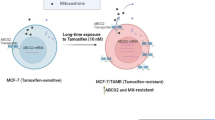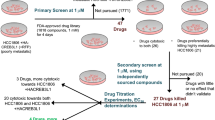Summary
The clinical utility of adriamycin in the treatment of patients with metastatic breast cancer is oftenlimited by the development of drug resistance. It has been recognized that in addition to the development of primary resistance against adriamycin, malignant cells can simultaneously develop cross-resistance to other agents. An adriamycin-resistant human breast cancer cell line (MCF 7Ad) was developed by exposing the parent line (MCF 7) to gradually increasing concentrations of adriamycin while the cells were being grown in monolayer. Using these lines in a clonogenic assay, the relative drug sensitivities to adriamycin, vinblastine, melphalan, 5-fluorouracil and methotrexate were studied. MCF 7Ad was 12.5-fold more resistant to adriamycin than MCF 7 and 500-fold cross-resistant to vinblastine. There was no cross-resistance to melphalan, 5-fluorouracil or methotrexate. The resistance of MCF 7Ad was decreased by simultaneous exposure to tamoxifen (by a factor of 3.33) or perhexiline maleate (by a factor of 7.50). This decreased resistance was evidenced by a shift to the left of the sensitivity curves. However, there was no consistent change in the sensitivity curves of MCF 7. At the selected concentration of tamoxifen and perhexiline maleate, the cloning efficiency of MCF 7 and MCF 7Ad was 80%–90% of control values in medium without tamoxifen, perhexiline maleate or cytotoxic drugs. The resistance of MCF 7Ad to adriamycin was associated with a lower accumulation of [14C]adriamycin than exhibited by the sensitive MCF 7 line. There was no consistent change in [14C]adriamycin accumulation in MCF 7 or MCF 7Ad when tamoxifen was added, but when perhexiline maleate was added the [14C] accumulation increased. These results suggest that the tamoxifen-induced change in MCF 7Ad adriamycin resistance was not due to an increase in the amount of cell-associated adriamycin, but rather to some other mechanism that increased the cytotoxicity of the adriamycin.
Similar content being viewed by others
Abbreviations
- RPMI 1640:
-
Roswell Park Memorial Institute medium 1640
- FBS:
-
fetal bovine serum
- PBS:
-
phosphate buffered saline
- trypsin-EDTA:
-
trypsin (w/0.05%) plus ethylenediaminetetraacetic acid (w/0.02%)
- IC50 :
-
concentration of each drug, extrapolated from concentration versus colony formation curve, that inhibits colony formation by 50% as compared to controls without exposure to the drug
References
Bosmann HB (1971) Mechanism of cellular drug resistance. Nature (London) 233: 566
Browman GP, Csullog GW (1981) Modification of in vivo methotrexate antitumour effect in L1210 leukemia by induced impairment of purine salvage. Biochem Pharmacol 30: 869
Bull JM, Tormey DC, Li SH, Carbone PP, Falkson G, Blom J, Perlin E, Simon R (1978) A randomized comparative trial of adriamycin versus methotrexate in combination drug therapy. Cancer 41: 1649
Burns CP, Lutteneger DG, Dudley DT, Buettner GR, Spector AA (1979) Effect of modification of plasma membrane fatty acid composition on fluidity and methotrexate transport in L1210 murine leukemia cells. Cancer Res 39: 1726
Chabner BA, Clendeninn NJ, Curt G (1983) Introduction to the symposium on cellular resistance to anticancer drugs. Cancer Treat Rep 67: 855
Chitnis MP, Johnson RK (1978) Biochemical parameters of resistance of an adriamycin resistant subline of P388 leukemia to emetine, an inhibitor of protein synthesis. J Natl Cancer Inst 60: 1049
Dano K (1972) Cross resistance between vinca alkaloids and anthracyclines in Ehrlich ascites tumor in vivo. Cancer Chemother Rep 56: 701
Endresen L, Bakka A, Rugstad HE (1983) Increased resistance to chlorambucil in cultured cells with a high concentration of cytoplasmic metallothionein. Cancer Res 43: 2918
Fisher B, Redmon C, Brown A, Wolmark N, Wittliff J, Fisher ER, Plotkin D, Bowman D, Sacks S, Woltner J, Frelick R, Desser R, LiCalzi N, Geggie P, Campbell T, Elias G, Proger D, Koontz P, Volk H, Dimitror N, Gardner B, Lerner H, Shibata H (1981) Treatment of primary breast cancer with chemotherapy and tamoxifen. NEJM 305: 1
Harris JR, Hellman S, Canellos GP, Fisher B (1985) Cancer of the breast. In: DeVita VT Jr, Hellman S, Rosenberg SA (eds) Cancer-principles and practice of oncology, 2nd edn. Lippincott, Philadelphia, p 1150
Ingle JN, Ahmann DL, Green SJ, Edmonson JH, Bisel HF, Kvols LK, Nichols WC, Creagan ET, Hahn RG, Rubin J, Frytak S (1981) Randomized clinical trial of diethylstilbesteral versus tamoxifen in postmenopausal women with advanced breast cancer. NEJM 304: 16
Johnson RK, Chitnis MP, Embrey WM, Gregory EB (1978) In vivo characteristics of resistance and cross resistance of an adriamycin resistant subline of P388 leukemia. Cancer Treat Rep 62: 1535
Kennealey GT, Boston B, Mitchell MS, Knobf MK, Borrow SN, Pezzimenti JF, Lawrence R, Bertino JR (1978) Combination chemotherapy for advanced breast cancer-two regimens containing adriamycin. Cancer 42: 27–33
Kessel D (1979) Enhanced glycosylation induced by adriamycin. Mol Pharmacol 16: 306
Ozols RF, Willson JKV, Grotzinger KR, Young RC (1980) Cloning of human ovarian cancer cell lines in soft agar from malignant effusions and peritoneal washings. Cancer Res 40: 2723
Pritchard KI, Thompson DB, Myers RE, Sutherland DJA, Mobbs BG, Meakin JW (1980) Tamoxifen therapy in premenopausal patients with metastatic breast cancer. Cancer Treat Rep 64: 787
Ramu A, Shan T, Glaubiger D (1983) Enhancement of doxorubicin and vinblastine sensitivity in anthracycline resistant P388 cells. Cancer Treat Rep 67: 895
Ramu A, Glaubiger D, Magrath IT, Joshi A (1983) Plasma membrane lipid structural order in doxorubicin sensitive and resistant P388 cells. Cancer Res 43: 5533
Ramu A, Fuks Z, Gatt S, Glaubiger D (1984) Reversal of acquired resistance to doxorubicin in P388 murine leukemia cells by perhexiline maleate. Cancer Res 44: 144
Ramu A, Glaubiger D, Fuks Z (1984) Reversal of acquired resistance to doxorubicin in P388 murine leukemia cells by tamoxifen and other triparanol analogues. Cancer Res 44: 4392
Ramu A, Glaubiger D, Weintraub H (1984) Differences in lipid composition of doxorubicin-sensitive and resistant P388 cells. Cancer Treat Rep 68: 637
Rogan AM, Hamilton TC, Young RC, Klecker RW, Ozols RF (1984) Reversal of adriamycin resistance by verapamil in human ovarian cancer. Science 224: 994
Rosso R, Boccardo F, Rubagotti A, Guarneri D (1983) Chemotherapy with and without tamoxifen in advanced breast cancer: preliminary results of a randomized trial. In: Periti, Grassi GG (eds) Current chemotherapy and immunotherapy, Proceedings of the 12th International Congress of Chemotherapy, vol II. American Society for Microbiology, Washington, p 1468
Smyth JF, Robins AB, Leese CL (1976) The metabolism of cytosine arabinoside as a predictive test for clinical response to the drug in acute myeloid leukemia. Eur J Cancer 12: 567
Soule HD, Vazquez J, Long A, Alberts S, Brennan M (1973) A human cell line from a pleural effusion derived from a breast carcinoma. J Natl Cancer Inst 51: 1409
Tormey DC, Falkson G, Crowley J, Falkson HC, Voelkel J, Davis TE (1982) Dibromodulcitol and adriamycin tamoxifen in advanced breast cancer. Am J Clin Oncol (CCT) 5: 33
Tsuruo T, Iida H, Tsukagoshi S, Sakurai Y (1982) Increased accumulation of vincristine and adriamycin in drug resistant P388 tumor cells following incubation with calcium antagonist and calmodulin inhibitors. Cancer Res 42: 4730
Wilkoff LJ, Dulmadge EA (1978) Resistance and cross resistance of cultured leukemia cells to vincristine, adriamycin, adriamycin analogs and actinomycin D. J Natl Cancer Inst 61: 1521
Author information
Authors and Affiliations
Rights and permissions
About this article
Cite this article
Foster, B.J., Grotzinger, K.R., McKoy, W.M. et al. Modulation of induced resistance to adriamycin in two human breast cancer cell lines with tamoxifen or perhexiline maleate. Cancer Chemother. Pharmacol. 22, 147–152 (1988). https://doi.org/10.1007/BF00257313
Received:
Accepted:
Issue Date:
DOI: https://doi.org/10.1007/BF00257313




